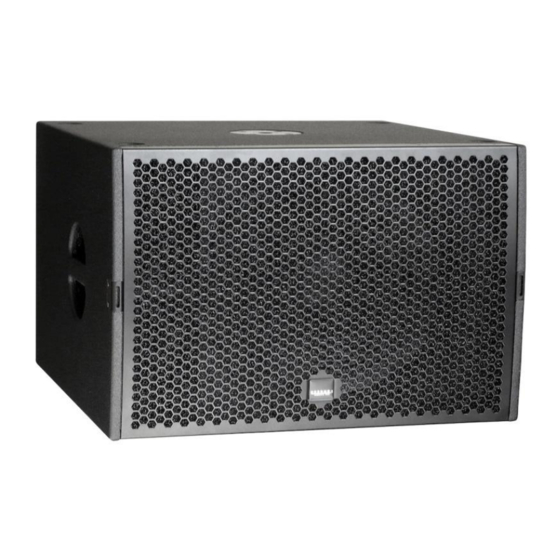Table of Contents
Advertisement
Quick Links
Advertisement
Table of Contents

Summary of Contents for Seeburg G Sub 1501 dp
- Page 1 Benutzerhandbuch G Sub 1501 dp Version 3.2 18.05.2020...
-
Page 2: Table Of Contents
G Sub 1501 dp 1 Contents Contents Contents ............................. 2 Foreword ............................. 3 Safety instructions ........................4 Connectors/Indicators ......................6 Connection panel ..........................6 Connectors ............................7 Controls ............................... 8 Status indication ..........................8 Operation ............................ 9 Starting up............................9 Selecting a bank .......................... -
Page 3: Foreword
2 Foreword Foreword The G Sub 1501 dp is a multi-functional premium class subwoofer with an integrated digital ampli- fier providing 2400 Watt @ 4 Ohm (AES) and a DSP controller. The 15” long-excursion driver is powered by the integrated amplifier. An additional subwoofer (e.g. G Sub 1501) can be connected to the SpeakOn parallel LS out connector. -
Page 4: Safety Instructions
G Sub 1501 dp 3 Safety instructions Safety instructions Acoustic Even a low input level can result in a sound pressure level at the loudspeaker which can be damaging to your hearing. Do not remain in close proximity to the loudspeaker when it is being operated. Use hearing protection. - Page 5 G Sub 1501 dp 3 Safety instructions If the loudspeaker is connected to a power source in which the volt- age is too high, a protective mechanism is triggered which reliably safeguards the amplifier module and DSP. Once triggered, the pro- tection must be renewed by a qualified service technician.
-
Page 6: Connectors/Indicators
G Sub 1501 dp 4 Connectors/Indicators Connectors/Indicators 4.1 Connection panel XLR connectors (1) SpeakON black (4) PowerCon grey (3) PowerCon blue (2) -
Page 7: Connectors
4.2 Connectors XLR connectors (1) The G Sub 1501 dp should be connected with a standard symmetrically wired XLR cable. To con- nect the input signal to further devices, use the male XLR Loop thru connector. To obtain full power performance from the system, the signal source should be able to provide a minimum of 6 dBu distortion free output voltage. -
Page 8: Controls
G Sub 1501 dp 4 Connectors/Indicators 4.3 Controls Mode button: Switch between the modes Status / Level and Presets. Set button: Set various values and Mute on/off. 4.4 Status indication Mute LED: Lights red when the system is muted (press the Set button in Status Mode), or in technically critical conditions. -
Page 9: Operation
G Sub 1501 dp 5 Operation Operation 5.1 Starting up When the system is switched on, it retains the settings from the previous usage. This also applies to the Bank selection. The system is then in the Status Mode. If the red Mute LED is lit as a result of the previous setting, no signal will be passed. -
Page 10: Setting Level
G Sub 1501 dp 5 Operation 5.3 Setting level Pressing the Mode button once selects the Level Mode, in which you can adjust the output volume in 3 dB steps. There are four settings available: +3 dB, 0 dB (standard), -3 dB and -6 dB. The setting is done by pressing the Set button. -
Page 11: Reprogramming Of Dp-Speakers With Preset Audio Files
3. Make sure your computer's volume is set to 100%. 4. Load the ".wav" file received from SEEBURG acoustic line into a music player. 5. Press the play button. 6. After a successful programming operation, the Mute LED turns off. -
Page 12: Cardioid Mode
Installation using two subwoofers: The G Sub 1501 dp that is in Cardioid Mode must be positioned such that the front of the unit is facing the rear, whilst a second G Sub 1501 dp which is not in Cardioid Mode faces the front as normal. - Page 13 Cardioid Mode. The two forwards facing units are operated as normal without the Cardioid Mode activated (e.g. one G Sub 1501 dp+ with a passive G Sub 1501 connected to the parallel output SpeakON (4) and the Cardioid Mode not selected). All of the subwoofers in the configuration should be operating at the same level and with the same cut-off frequency to get the best result.
-
Page 14: Technical Specifications
G Sub 1501 dp 6 Technical specifications Technical specifications Speaker Components 15" Nd Description Digitally Powered Bass Extension Amp Power 1500 W AES (single Mode) / 110-230 V 2400 W AES (dual Mode) / 110-230 V Rated Current 3,8 A @ 230 V... -
Page 15: Declaration Of Conformity
DIN EN 60065 DIN EN 55103-1:1996, classes E1 to E4 DIN EN 55103-2:1996, classes E1 to E4 Declared by: Winfried Seeburg, SEEBURG acoustic line GmbH Place and date: Senden, 01.01.2010 Legally binding sign: ____________________________________________ The attachments constitute part of this declaration. This declaration certifies conformity with the listed guidelines, but does not guarantee any product characteristics. - Page 16 Benutzerhandbuch / User Manual Irrtum bei Beschreibung sowie technische Änderungen vorbehalten. Alle SEEBURG acoustic line Produkte sind nur für den gewerblichen Einsatz bestimmt. All specifications are current at the time of publishing but are subject to change. SEEBURG acoustic line...





Need help?
Do you have a question about the G Sub 1501 dp and is the answer not in the manual?
Questions and answers